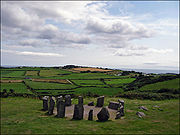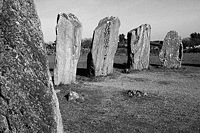
Drombeg stone circle
Encyclopedia

Glandore
Glandore |Cork]] city.The village has several pubs, with traditional music. It is a very popular holiday destination for Irish holiday makers in particular. Famous homeowners include Margaret Jay, former leader of the House of Lords, and Tony O'Reilly. The village yacht club's official headquarters...
, County Cork
County Cork
County Cork is a county in Ireland. It is located in the South-West Region and is also part of the province of Munster. It is named after the city of Cork . Cork County Council is the local authority for the county...
, Ireland
Republic of Ireland
Ireland , described as the Republic of Ireland , is a sovereign state in Europe occupying approximately five-sixths of the island of the same name. Its capital is Dublin. Ireland, which had a population of 4.58 million in 2011, is a constitutional republic governed as a parliamentary democracy,...
. (grid ref: 24672 35157, Latitude: 51.564553N Longitude: 9.08702W) Drombeg is one of the most visited megalithic sites in Ireland. The area of the circle has been covered in gravel to protect it from the volume of visitors.
Features
The stone circle consists of seventeen closely spaced stones spanning 9 m (29 ft) in diameter, of which 13 survive. The most westerly stone (1.9m high) is the long recumbent and has two egg shaped cup-markCup and ring mark
Cup and ring marks or cup marks are a form of prehistoric art found mainly in Atlantic Europe and Mediterranean Europe although similar forms are also found throughout the world including Mexico, Brazil, Greece, and India, where...
s, one with a ring around it. A "Cork-Kerry type" stone circle, it is flanked by a pair of 1.8m high axial portal stones, which provide a south-west axis, and orientate the monument in the direction of the setting sun during the midwinter solstice
Solstice
A solstice is an astronomical event that happens twice each year when the Sun's apparent position in the sky, as viewed from Earth, reaches its northernmost or southernmost extremes...
. The stones in the circle have been shaped to slope upwards to the recumbent stone, the midpoint of which was set in line with the winter solstice sunset viewed in a conspicuous notch in the distant hills. While the alignment is good, it is not precise.
The ruins of two round stone walled conjoined prehistoric huts and a fulacht fiadh
Fulacht fiadh
A fulacht fiadh is a type of archaeological site found in Ireland. In England, Scotland, Wales and the Isle of Man they are known as burnt mounds. They commonly survive as a low horseshoe-shaped mound of charcoal-enriched soil and heat shattered stone with a slight depression at its centre showing...
lie just 40m west of the monument. Evidence suggests the fulacht fiadh was in use up until the 5th century AD. The larger of the huts had a timber roof supported by a timber post. The smaller hut had a cooking oven on its east side. A causeway leads from the huts to the cooking place (fulacht fiadh) featuring a hearth, well and trough in which water was boiled by adding hot stones.
Excavations

Sources
- Noonan, Damien (2001). "Castles & Ancient Monuments of Ireland", Arum Press. ISBN 1-8541-0752-6

